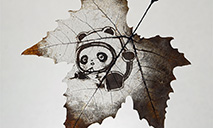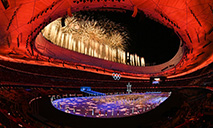Ancient Chinese ritual parades on in modern time
XI'AN, Feb. 24 (Xinhua) -- Dipping a brush into the paint and delineating the lines cautiously with his wrinkled fingers, Wang Qiming put traditional make-up on the faces of young performers before dawn, making final preparations for the Shehuo parade.
At sunrise, the quiet country road in Wangmazui Village of Tiancheng Township in Longxian County in the city of Baoji, northwest China's Shaanxi Province, was enlivened by gongs and drums and became an exhilarating affair.
The Shehuo parade, a time-honored performance enjoying widespread popularity in rural areas across China, originated from ancient sacrificial activities to pray for a good harvest about 2,000 years ago.
Later on, as dancing and singing performances were absorbed into the parade, it gradually evolved into a folk custom staged during the Spring Festival and Lantern Festival, believed to remove bad luck and bring a fresh start in the new year.
The Shehuo folk performance in Baoji made it onto the list of China's national intangible cultural heritage in 2006.
Longxian County, referred to as Long Zhou in the old days, is well-known for the local Shehuo parade featuring authentic and inclusive performance and simple yet exquisite facial make-up. It was named as the hometown of Chinese Shehuo performances by the Chinese Folk Literature and Art Association in 2013.
More than 100 Shehuo festivities are staged in Longxian every year, each involving dozens of or hundreds of villagers. Revelers usually perform on horses or pickup trucks, showing scenes from classic novels like "Romance of the Three Kingdoms" and "Investiture of the Gods." Different genres of performances include stilt dances, land boats, and so on.
Wang Qiming, 65, remembered the annually-held performances in his childhood clearly. "My families have engaged in Shehuo performances for generations. I started to watch the show in my childhood, and now I join them by making face-painting," he said.
"My son can sing Long Zhou folk tunes, and my grandsons are learning drums and cymbals," he added.
Many young people bring in new blood for the age-old art. Ma Liang, a 20-year-old young man, went back home to Longxian County before this Chinese New Year. Knowing that Shehuo performances would come to his village, he took the initiative to join the troupe.
"Every year, when the locals stage Shehuo performances, the villages burst into a carnival of drums and gongs. I grew interested in it when I was young. This year I learned to ride a horse and will give a show on the horse," he said.
Local schools also offer after-class courses related to Shehuo. In Wangmazui Village, students in the third and fourth grades in the local primary school can learn drums and gongs twice a week since last October, and some of them have performed during this year's Spring Festival.
Several companies related to Shehuo performances have been set up in the county and have performed shows across the villages. It further promotes the development of the local folk art, said Su Liming, the head of the local cultural center.
In Dayuan Village of Baoji, various delicate props and glamorous dresses are showcased in a museum themed on Shehuo. Historical records show that local folk associations began to stage Shehuo festivities at the end of the Qing Dynasty (1644-1911).
"The Shehuo parade is the cultural root of Longxian, and generations of locals will keep passing it on," said Su.
Photos
Related Stories
- Demonstration of China's intangible cultural heritage held at Great Hall of People in Beijing
- Cherishing all things with a love for people, nature
- Down a bowl of douzhi, taste a unique snack enjoyed by Beijingers
- China's cultural industry expands steadily in 2020: NBS
- Inside China Ep.6: Are ethnic cultures being protected in China?
Copyright © 2022 People's Daily Online. All Rights Reserved.










